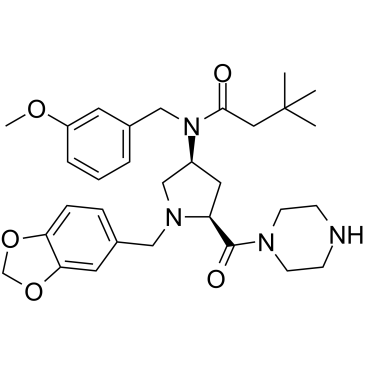CUR-61414
Modify Date: 2024-01-03 12:39:21

CUR-61414 structure
|
Common Name | CUR-61414 | ||
|---|---|---|---|---|
| CAS Number | 334998-36-6 | Molecular Weight | 550.689 | |
| Density | 1.3±0.1 g/cm3 | Boiling Point | 714.1±60.0 °C at 760 mmHg | |
| Molecular Formula | C31H42N4O5 | Melting Point | N/A | |
| MSDS | Chinese USA | Flash Point | 385.7±32.9 °C | |
| Symbol |

GHS06 |
Signal Word | Danger | |
Use of CUR-61414CUR61414 is a novel, potent and cell permeable Hedgehog signaling pathway inhibitor (IC50 =100-200 nM). CUR61414 is a small-molecule aminoproline class compound and selectively binds to smoothened (Smo) with a Ki value of 44 nM. CUR-61414 can induce apoptosis in cancer cells without affecting neighboring non-tumor cells[1][2]. |
| Name | N-[(3S,5S)-1-(1,3-benzodioxol-5-ylmethyl)-5-(piperazine-1-carbonyl)pyrrolidin-3-yl]-N-[(3-methoxyphenyl)methyl]-3,3-dimethylbutanamide |
|---|---|
| Synonym | More Synonyms |
| Description | CUR61414 is a novel, potent and cell permeable Hedgehog signaling pathway inhibitor (IC50 =100-200 nM). CUR61414 is a small-molecule aminoproline class compound and selectively binds to smoothened (Smo) with a Ki value of 44 nM. CUR-61414 can induce apoptosis in cancer cells without affecting neighboring non-tumor cells[1][2]. |
|---|---|
| Related Catalog | |
| Target |
Hedgehog inhibitor[1] |
| In Vitro | CUR61414 is able to arrest proliferation of basal cells within the BCC-like lesions and induce cells to undergo apoptosis resulting in complete regression of the lesions, without affecting neighboring skin cells[1]. |
| In Vivo | CUR61414 cause regression of these lesions in the mice, which are exposed to UV light irradiation for 6-9 months, producing many microscopic BCC-like basaloid lesions throughout their skin. Moreover,a significant increase in apoptotic nuclei can be seen in basaloid nests after CUR61414 treatment and no overt toxicity is observed in the skin surrounding the lesions[1]. |
| References |
| Density | 1.3±0.1 g/cm3 |
|---|---|
| Boiling Point | 714.1±60.0 °C at 760 mmHg |
| Molecular Formula | C31H42N4O5 |
| Molecular Weight | 550.689 |
| Flash Point | 385.7±32.9 °C |
| Exact Mass | 550.315491 |
| PSA | 83.58000 |
| LogP | 3.28 |
| Vapour Pressure | 0.0±2.3 mmHg at 25°C |
| Index of Refraction | 1.616 |
| Symbol |

GHS06 |
|---|---|
| Signal Word | Danger |
| Hazard Statements | H301 |
| Precautionary Statements | P301 + P310 |
| Hazard Codes | T+ |
| RIDADR | UN 2811 6.1 / PGIII |
| N-[(3S,5S)-1-(1,3-Benzodioxol-5-ylmethyl)-5-(1-piperazinylcarbonyl)-3-pyrrolidinyl]-N-(3-methoxybenzyl)-3,3-dimethylbutanamide |
| N-((3S,5S)-1-(benzo[d][1,3]dioxol-5-ylmethyl)-5-(piperazine-1-carbonyl)pyrrolidin-3-yl)-N-(3-methoxybenzyl)-3,3-dimethylbutanamide |
| Butanamide,N-[(3S,5S)-1-(1,3-benzodioxol-5-ylmethyl)-5-(1-piperazinylcarbonyl)-3-pyrrolidinyl]-N-[(3-methoxyphenyl)methyl]-3,3-dimethyl |
| Butanamide, N-[(3S,5S)-1-(1,3-benzodioxol-5-ylmethyl)-5-(1-piperazinylcarbonyl)-3-pyrrolidinyl]-N-[(3-methoxyphenyl)methyl]-3,3-dimethyl- |
| N-[(3S,5S)-1-(1,3-BENZODIOXOL-5-YLMETHYL)-5-((PIPERAZIN-1-YL)CARBONYL)-3-PYRROLIDINYL]-N-[(3-METHOXYPHENYL)METHYL]-3,3-DIMETHYLBUTANAMIDE |